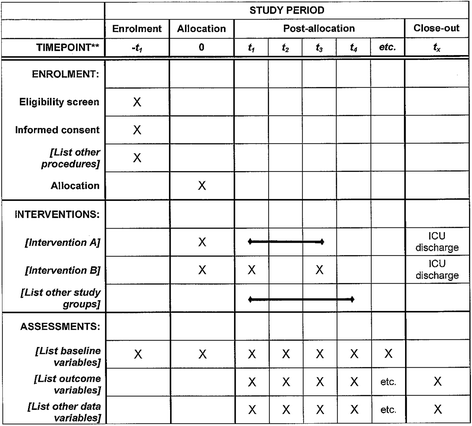High-flow nasal oxygen vs. standard oxygen therapy in immunocompromised patients with acute respiratory failure: study protocol for a randomized controlled trial
- PMID: 29506579
- PMCID: PMC5836389
- DOI: 10.1186/s13063-018-2492-z
High-flow nasal oxygen vs. standard oxygen therapy in immunocompromised patients with acute respiratory failure: study protocol for a randomized controlled trial
Abstract
Background: Acute respiratory failure (ARF) is the leading reason for intensive care unit (ICU) admission in immunocompromised patients. High-flow nasal oxygen (HFNO) therapy is an alternative to standard oxygen. By providing warmed and humidified gas, HFNO allows the delivery of higher flow rates via nasal cannula devices, with FiO2 values of nearly 100%. Benefits include alleviation of dyspnea and discomfort, decreased respiratory distress and decreased mortality in unselected patients with acute hypoxemic respiratory failure. However, in preliminary reports, HFNO benefits are controversial in immunocompromised patients in whom it has never been properly evaluated.
Methods/design: This is a multicenter, open-label, randomized controlled superiority trial in 30 intensive care units, part of the Groupe de Recherche Respiratoire en Réanimation Onco-Hématologique (GRRR-OH). Inclusion criteria will be: (1) adults, (2) known immunosuppression, (3) ARF, (4) oxygen therapy ≥ 6 L/min, (5) written informed consent from patient or proxy. Exclusion criteria will be: (1) imminent death (moribund patient), (2) no informed consent, (3) hypercapnia (PaCO2 ≥ 50 mmHg), (4) isolated cardiogenic pulmonary edema, (5) pregnancy or breastfeeding, (6) anatomical factors precluding insertion of a nasal cannula, (7) no coverage by the French statutory healthcare insurance system, and (8) post-surgical setting from day 1 to day 6 (patients with ARF occurring after day 6 of surgery can be included). The primary outcome measure is day-28 mortality. Secondary outcomes are intubation rate, comfort, dyspnea, respiratory rate, oxygenation, ICU length of stay, and ICU-acquired infections. Based on an expected 30% mortality rate in the standard oxygen group, and 20% in the HFNO group, error rate set at 5%, and a statistical power at 90%, 389 patients are required in each treatment group (778 patients overall). Recruitment period is estimated at 30 months, with 28 days of additional follow-up for the last included patient.
Discussion: The HIGH study will be the largest multicenter, randomized controlled trial seeking to demonstrate that survival benefits from HFNO reported in unselected patients also apply to a large immunocompromised population.
Trial registration: ClinicalTrials.gov, ID: NCT02739451 . Registered on 15 April 2016.
Keywords: Acute respiratory failure; High-flow oxygen; Immunocompromised Hematology; Immunosuppression; Intubation; Mortality; Oxygen.
Conflict of interest statement
Ethics approval and consent to participate
The study was approved by the IRB of the St. Louis Hospital. All patients or relatives provided signed informed consent.
Consent for publication
All authors consent to see this protocol article published. All have given input on the submitted version and approved it.
Competing interests
None of the authors has any conflict of interest in relation with this study. The institutions of Elie Azoulay, Samir Jaber, Alexandre Demoule and Virginie Lemiale have received scientific support from Fisher & Payckle outside this study.
Publisher’s Note
Springer Nature remains neutral with regard to jurisdictional claims in published maps and institutional affiliations.
Similar articles
-
High-Flow Nasal Cannula Oxygenation in Immunocompromised Patients With Acute Hypoxemic Respiratory Failure: A Groupe de Recherche Respiratoire en Réanimation Onco-Hématologique Study.Crit Care Med. 2017 Mar;45(3):e274-e280. doi: 10.1097/CCM.0000000000002085. Crit Care Med. 2017. PMID: 27655324 Clinical Trial.
-
The effects of a 2-h trial of high-flow oxygen by nasal cannula versus Venturi mask in immunocompromised patients with hypoxemic acute respiratory failure: a multicenter randomized trial.Crit Care. 2015 Nov 2;19:380. doi: 10.1186/s13054-015-1097-0. Crit Care. 2015. PMID: 26521922 Free PMC article. Clinical Trial.
-
Effect of High-Flow Nasal Oxygen vs Standard Oxygen on 28-Day Mortality in Immunocompromised Patients With Acute Respiratory Failure: The HIGH Randomized Clinical Trial.JAMA. 2018 Nov 27;320(20):2099-2107. doi: 10.1001/jama.2018.14282. JAMA. 2018. PMID: 30357270 Free PMC article. Clinical Trial.
-
Effect of High-Flow Nasal Cannula Oxygen Therapy in Immunocompromised Subjects With Acute Respiratory Failure.Respir Care. 2020 Mar;65(3):369-376. doi: 10.4187/respcare.07205. Epub 2019 Nov 19. Respir Care. 2020. PMID: 31744865 Review.
-
[High flow, humidified-reheated oxygen therapy: a new oxygenation technique for adults].Rev Mal Respir. 2013 Oct;30(8):627-43. doi: 10.1016/j.rmr.2013.04.016. Epub 2013 May 29. Rev Mal Respir. 2013. PMID: 24182650 Review. French.
Cited by
-
The effectiveness of transnasal high flow nasal cannula in bronchoscopy under sedation: a systematic review and meta-analysis.Front Med (Lausanne). 2024 Jul 10;11:1428431. doi: 10.3389/fmed.2024.1428431. eCollection 2024. Front Med (Lausanne). 2024. PMID: 39050533 Free PMC article.
-
Acute respiratory failure in immunocompromised adults.Lancet Respir Med. 2019 Feb;7(2):173-186. doi: 10.1016/S2213-2600(18)30345-X. Epub 2018 Dec 7. Lancet Respir Med. 2019. PMID: 30529232 Free PMC article. Review.
-
Advances in Therapeutics for Chronic Lung Diseases: From Standard Therapies to Emerging Breakthroughs.J Clin Med. 2025 Apr 30;14(9):3118. doi: 10.3390/jcm14093118. J Clin Med. 2025. PMID: 40364149 Free PMC article. Review.
-
Clinical efficacy of high-flow nasal humidified oxygen therapy in patients with hypoxemia.PLoS One. 2019 Jun 6;14(6):e0216957. doi: 10.1371/journal.pone.0216957. eCollection 2019. PLoS One. 2019. PMID: 31170182 Free PMC article. Clinical Trial.
-
Preoxygenation strategies before intubation in patients with acute hypoxic respiratory failure: a network meta-analysis.Front Med (Lausanne). 2025 Feb 10;12:1532911. doi: 10.3389/fmed.2025.1532911. eCollection 2025. Front Med (Lausanne). 2025. PMID: 39995692 Free PMC article.
References
-
- Dumas G, Geri G, Montlahuc C, et al. Outcomes in critically ill patients with systemic rheumatic disease: a multicenter study. Chest. 2015;2015(21):14–3098. - PubMed
-
- Azoulay E, Pene F, Darmon M, et al. Managing critically Ill hematology patients: time to think differently. Blood Rev. 2015;2015(26):00030–00032. - PubMed
Publication types
MeSH terms
Associated data
Grants and funding
LinkOut - more resources
Full Text Sources
Other Literature Sources
Medical
Research Materials
Miscellaneous


